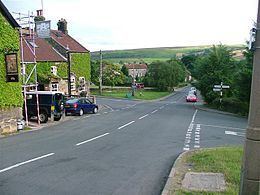Population 1,411 (2011 census) Civil parish Danby Sovereign state United Kingdom | OS grid reference NZ707085 Local time Wednesday 11:00 PM District Borough of Scarborough | |
 | ||
Weather 7°C, Wind SW at 19 km/h, 85% Humidity | ||
Walk 635 danby north yorkshire moors
Danby is a village and civil parish in the Scarborough district of North Yorkshire, England. According to the 2001 UK census, Danby parish had a population of 1,411, a reduction on the 2001 UK census figure of 1,515. The statistician Karl Pearson spent a lot of time there.
Contents
- Walk 635 danby north yorkshire moors
- Map of Danby UK
- Governance
- Danby Castle
- Danby Show
- Church history
- Danby Beacon
- References
Map of Danby, UK
Danby is located within the North York Moors National Park and is home to The Moors National Park Centre.
Danby is served by a rail network between Middlesbrough and Whitby and an Arriva bus service. Danby village incorporates the Duke of Wellington pub, and the neighbouring Post Office. The village lies on the Esk Valley Walk.
The civil parish includes the following villages/settlements:
Governance
An electoral ward in the same name exists. This ward had a population of 2,072 at the 2011 Census.
Danby Castle
A little over a mile to the south-east are the remains of Danby Castle.
Danby Castle occupies a commanding position on the far slopes of Danby Rigg. It was built in the 14th century for Lord Latimer as a sign of his great wealth and, in its day, was of pioneering architectural design, combining both defence and comfortable living. Catherine Parr once lived at the castle, before she became the sixth wife of Henry VIII. The castle is now a wedding venue; part of the building is now a farmhouse and the venue owners' family home. Danby court leet, the all male, baronial court whose origins were as a manorial court, but whose functions are now restricted to the management of common land, regularly meets in the castle's courtroom.
Danby Show
The Danby Agricultural show is held every year in August, with traditional country entertainments and activities such as show jumping, sheepdog trials, exhibitions of farm animals and machinery as well as horticultural, craft and produce competitions.
Church history
Daniel Duck (1743-?1825) was the vicar of Danby from 1780 until he was succeeded by his son Joseph in 1825. Joseph came from Sidney Sussex College, Cambridge and his family was one of yeoman freeholders in the Yorkshire Dales. He is commemorated in the poem, Lines in Memory of the Rev. D. Duck, Curate of Danby.
The Rev. John Christopher Atkinson was Vicar of Danby 1850–1900 and author of Forty Years in a Moorland Parish, 1891.
Danby Beacon
The Danby Beacon was one of a line of beacons up to twenty miles apart, and dates back to the 1600s when the country was living under the threat of invasion from France. It was to have been lit when the soldier stationed nearby had sight of a foreign fleet.
Danby Beacon is now a national landmark, which is used as a reference point by thousands of visitors and walkers each year. Over the years, the old wooden beacon aged so much that it eventually disintegrated and fell down – the landmark was lost.
A new beacon was unveiled in 2008 by Lord Downe, President of the Danby Beacon Trust. The flame-shaped basket is made out of blued stainless steel, blending in with the sky. The flames are mounted around a cup that is decorated with bronze – a reminder of the Bronze Age burial mound which part occupies the site.
During the Second World War, the site became home to one of the first radar stations guarding the north-east coast. The station was responsible for guiding Group Captain Peter Townsend, when he intercepted and shot down the first enemy aircraft to fall on English soil during the war.
The radar station, which continued to function until 1957, was the precursor of the RAF Fylingdales early warning station, 15 miles south-east, whose three giant golf balls became one of the North York Moors National Park's biggest attractions.
